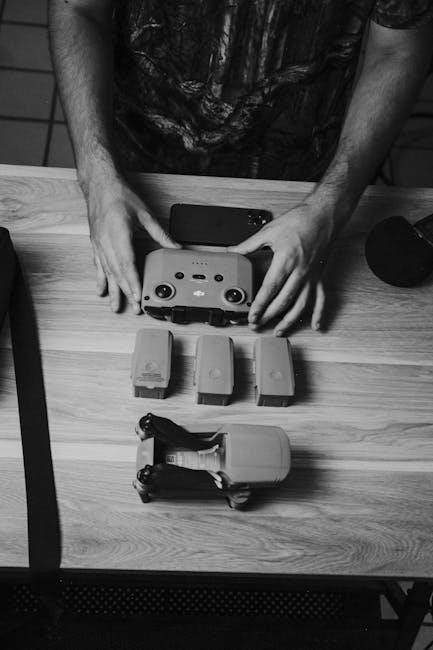boss rc 300 manual
The Boss RC-300 is a powerful loop station designed for musicians to record, playback, and manipulate audio phrases. This manual guides users through its features, ensuring optimal performance and creativity in live settings.
1.1 Overview of the Boss RC-300
The Boss RC-300 is a versatile loop station designed for musicians to create and manipulate audio loops in real-time. It offers three stereo tracks for simultaneous recording and playback, allowing for layered soundscapes. With a user-friendly interface, the RC-300 supports guitar, vocal, and external audio inputs, making it ideal for both instrumentalists and vocalists. The device features a built-in LED display for easy navigation and customizable controls for effects and rhythms. Its robust design and intuitive functionality make it a popular choice for live performances and studio sessions. The RC-300 also supports USB connectivity, enabling seamless audio transfer and integration with computer-based music systems. This loop station is a powerful tool for enhancing creativity and delivering professional-quality sound.
1.2 Importance of the Manual for Musicians
The Boss RC-300 manual is an essential resource for musicians seeking to unlock the full potential of this loop station. It provides detailed instructions on operating the device, from basic recording to advanced features like MIDI synchronization and effects customization. The manual ensures users can navigate the interface efficiently, understand the various settings, and troubleshoot common issues. For both beginners and experienced musicians, the guide offers insights into maximizing creativity and achieving professional-quality sound. By following the manual, users can optimize their workflow, explore new sonic possibilities, and enhance their overall performance. This comprehensive guide is indispensable for anyone looking to master the RC-300 and integrate it seamlessly into their musical endeavors.
Key Features of the Boss RC-300
The Boss RC-300 is a triple stereo mega looper with 3 hours of recording time, 99 phrase memories, and built-in effects like chorus, phaser, and robotic voice.
2.1 Maximum Recording Time and Phrase Memories
The Boss RC-300 offers an impressive maximum recording time of up to three hours in stereo, providing ample space for creative loops and performances. With 99 phrase memories, users can store and organize their loops efficiently. This feature allows musicians to layer sounds in real-time, creating complex and dynamic performances. The device ensures high-quality audio reproduction, making it ideal for both live gigs and studio sessions. The generous memory capacity and long recording time make the RC-300 a versatile tool for artists seeking to explore extensive looping possibilities without running out of space. This capability enhances the overall creative potential, making it a favorite among loop enthusiasts and professional musicians alike.

2.2 Types of Inputs and Outputs
The Boss RC-300 features a variety of inputs and outputs to accommodate different audio sources and setups. It includes an INST input for guitars, a MIC input for microphones, and an AUX IN for external audio devices. The outputs consist of two 1/4-inch jacks for connecting to amplifiers or mixers, a headphone output for monitoring, and a MIDI interface for synchronizing with external devices. Additionally, the RC-300 has a USB port for direct connection to computers, enabling easy file transfers and MIDI control. These versatile input and output options provide flexibility for musicians to integrate the RC-300 into their rigs, whether for live performances or studio recording. The wide range of connectivity ensures seamless integration with various audio equipment, enhancing the overall user experience.
2.3 Built-in Effects and Rhythms
The Boss RC-300 is equipped with a wide range of built-in effects and rhythms to enhance your musical performances. It includes effects such as chorus, phaser, and robotic voice, which can add depth and unique textures to your loops. These effects can be applied in real-time, allowing for dynamic manipulation of your audio. Additionally, the RC-300 features 83 built-in rhythms, covering various musical genres and styles. These rhythms can be synchronized with your loops, providing a solid foundation for your performances. The effects and rhythms are easily accessible via the control panel, enabling seamless integration into your creative process. This versatility makes the RC-300 an invaluable tool for musicians seeking to expand their sonic possibilities and create engaging live performances.
2.4 USB Connectivity for Computer Interaction
The Boss RC-300 features USB connectivity, enabling seamless interaction with computers. This allows users to transfer audio files between the RC-300 and their computer, expanding storage and editing capabilities. The USB connection also enables the RC-300 to function as a MIDI control surface, facilitating integration with digital audio workstations (DAWs) for recording and playback. This feature is particularly useful for musicians who want to enhance their live performances with backing tracks or external effects. Additionally, the USB connection provides a convenient way to back up your loops and settings, ensuring your creative work is safely stored. This connectivity option further enhances the RC-300’s versatility, making it a powerful tool for both live and studio applications.
2.5 LED Display and Power Options
The Boss RC-300 is equipped with a backlit LED display, providing clear visibility of settings and options, even in low-light environments. This feature is essential for musicians performing on stage or in dimly lit studios. The device also offers flexible power options, including an AC adapter for reliable operation during performances. Additionally, the RC-300 features an Auto Power Off function, which automatically turns the unit off after 10 hours of inactivity to conserve power. Users can disable this feature if they prefer continuous operation. The LED display ensures easy navigation through the device’s menus, while the robust power options guarantee uninterrupted use during live performances or recording sessions. These features make the RC-300 a reliable and user-friendly tool for musicians seeking professional-grade loop station functionality.
Product Specifications
The Boss RC-300 features a 16-bit bit rate, 44.1 kHz sample rate, and 2000 Ω output impedance, ensuring high-quality audio. Its dimensions are 536 mm (width), 231 mm (depth), and 76 mm (height), with a weight of 3900 g.
3.1 Bit Rate and Sample Rate
The Boss RC-300 operates with a 16-bit bit rate, delivering clear and high-quality audio output. It also features a sample rate of 44.1 kHz, which is standard for professional audio recordings, ensuring crisp and detailed sound reproduction. These specifications are essential for maintaining the integrity of your loops and performances, providing a robust foundation for creative expression. The 16-bit resolution captures a wide dynamic range, while the 44.1 kHz sample rate accurately represents the nuances of your audio. Together, these technical attributes make the RC-300 a reliable tool for musicians seeking precise and professional-grade sound quality in their looping and layering processes.
3.2 Output Impedance and Audio Quality
The Boss RC-300 features an output impedance of 2000 Ω, ensuring compatibility with a wide range of audio devices and maintaining high-quality sound output. The device supports a 16-bit bit rate, which provides clear and detailed audio reproduction. With a sample rate of 44.1 kHz, the RC-300 delivers professional-grade sound quality, capturing the nuances of your recordings accurately. The LED display enhances visibility, allowing easy navigation of settings, while the AC power option ensures uninterrupted performance. These specifications make the RC-300 a reliable choice for musicians seeking consistent and high-fidelity audio output in their looping and live performances.
3.3 Physical Dimensions and Weight
The Boss RC-300 measures 536 mm in width, 231 mm in depth, and 76 mm in height, making it a compact and portable device for musicians. Weighing 3900 grams, it is sturdy yet lightweight enough for easy transport between performances. Its robust design ensures durability, even with frequent use. The dimensions and weight are optimized for pedalboard placement, allowing seamless integration into your setup. This balance of size and weight makes the RC-300 ideal for both studio and live environments, providing reliable performance without compromising portability. The physical design complements its advanced features, offering a practical solution for loop-based music creation and manipulation.
3.4 Built-in Rhythms and Effects

The Boss RC-300 comes equipped with 83 built-in rhythms, offering a wide range of musical styles to enhance your performances. These rhythms provide versatile backing options, from rock to jazz, allowing you to experiment with different genres. Additionally, the RC-300 features a variety of built-in effects, including chorus, phaser, and robotic voice, which can be applied to your loops and recordings. These effects add depth and creativity to your sound, enabling you to craft unique and engaging performances. The effects can be synchronized with the tempo of your tracks, ensuring seamless integration during playback. With these built-in rhythms and effects, the RC-300 empowers musicians to explore new sonic possibilities and elevate their live shows or studio sessions.

How to Use the Boss RC-300
The Boss RC-300 allows musicians to record, layer, and playback audio phrases in real time. It supports synchronization with MIDI devices and offers effects application for enhanced sound.
4.1 Saving and Managing Loops

To save a loop on the Boss RC-300, press the WRITE button, select a memory location using the MEMORY knob, and press WRITE again to confirm. The RC-300 offers up to 99 phrase memories, allowing you to store and organize your loops efficiently. Each memory can hold up to three hours of stereo audio, providing ample space for creative experimentation. For better organization, loops can be categorized into folders and backed up to your computer via USB. This feature ensures your work is safe and easily accessible for future performances. Managing loops is intuitive, with options to delete or overwrite memories as needed. Properly saving and organizing your loops enhances workflow and ensures seamless live performances.
4.2 Synchronizing with MIDI Devices
To synchronize the Boss RC-300 with MIDI devices, connect the MIDI OUT of your external device to the MIDI IN on the RC-300. Navigate to the System menu and enable MIDI Sync, ensuring the RC-300 responds to incoming MIDI clock signals. This allows the loop station to align its tempo with other MIDI-compatible gear. You can also control the RC-300 using an external MIDI controller, enabling remote operation of functions like play, stop, and record. The LED display provides visual feedback for MIDI activity, ensuring precise synchronization. Proper MIDI setup enhances live performances and studio workflows, allowing seamless integration with drum machines, sequencers, or other MIDI devices. This feature is essential for musicians seeking to synchronize their loops with external equipment.
4.3 Applying Effects to Loops
The Boss RC-300 allows you to enhance your loops with a variety of built-in effects, including chorus, phaser, and robotic voice. To apply effects, press the FX button to enter the effects menu. Use the EFFECT TYPE knob to select the desired effect, and adjust the EFFECT LEVEL knob to set the intensity. You can also assign specific effects to individual tracks for greater control over your sound. The effects are synchronized with the loop’s tempo, ensuring seamless integration. Experimenting with these effects can add depth and creativity to your performances. The LED display provides clear feedback, making it easy to navigate and adjust effects in real time. This feature is a powerful tool for musicians looking to enhance their loops with professional-quality sound processing.

4.4 Connecting to a Computer via USB
To connect the Boss RC-300 to a computer via USB, use a standard USB cable. This connection enables you to transfer audio files between the RC-300 and your computer, as well as use the device as a MIDI control surface. Once connected, the RC-300 appears as a MIDI device in your recording software, allowing for seamless integration with digital audio workstations (DAWs). This feature is ideal for backing up loops, importing new audio material, or synchronizing MIDI data for advanced productions.
Ensure your computer has the latest Boss RC-300 drivers installed for optimal compatibility. The USB connection also powers the device, making it convenient for studio use. This feature enhances the RC-300’s versatility, bridging the gap between live performance and computer-based music production.

Accessing and Understanding the Manual
The Boss RC-300 manual is available as a PDF download from Boss’s official website and Manuals.co.uk. It provides detailed instructions, specifications, and troubleshooting guides in multiple languages, including English.
5.1 Downloading the PDF Manual
To download the Boss RC-300 manual, visit the official Boss website or trusted platforms like Manuals.co.uk. Navigate to the support section, select the RC-300 from the product list, and choose the PDF manual option. Some sites may require verifying your request by entering a verification code before downloading. The manual is available in multiple languages, including English, and is free to access. Once downloaded, you can view it online or print it for convenience. The PDF manual provides comprehensive guidance on using the RC-300, including setup, features, and troubleshooting. Ensure you download the correct version for your device to access accurate and detailed instructions.
5.2 Navigating the Manual’s Content
The Boss RC-300 manual is organized into clear sections, making it easy to navigate. Start with the table of contents or index to locate specific topics. The manual begins with an introduction to the device, followed by detailed explanations of its features, such as loop recording, effects, and MIDI synchronization. Practical examples and diagrams are included to guide users through complex functions. Sections like “Getting Started” and “Troubleshooting” provide quick solutions for common issues. The manual also covers advanced techniques, ensuring both beginners and experienced musicians can benefit. By exploring each chapter systematically, users can unlock the full potential of the RC-300 and enhance their musical creativity.
5.3 Language Availability
The Boss RC-300 manual is primarily available in English, ensuring accessibility for a global audience. However, BOSS also provides translations in multiple languages to cater to users worldwide. This multilingual support allows musicians from diverse regions to understand and utilize the device’s features effectively. The English version is the most comprehensive and is widely available on the official BOSS website and other trusted sources. For users who prefer other languages, regional BOSS support pages often offer translated manuals. This linguistic diversity ensures that the RC-300 remains user-friendly across different countries and cultures, fostering creativity and performance without language barriers.
Troubleshooting Common Issues
The Boss RC-300 manual addresses common issues like audio playback problems, MIDI synchronization errors, and factory reset procedures, ensuring smooth operation and resolving technical difficulties effectively.
6.1 Resolving Audio Playback Problems

Audio playback issues on the Boss RC-300 can often be resolved by checking the volume levels and ensuring proper connections. If no sound is output, verify that the volume is not muted or set too low. Ensure all cables are securely connected to the correct inputs and outputs. Restarting the device may also resolve temporary glitches. If problems persist, check the audio files for corruption or improper formatting. Additionally, ensure the RC-300 is updated with the latest firmware, as outdated software can cause compatibility issues. For severe cases, resetting the unit to factory settings may be necessary, but this will erase all saved data, so back up your loops beforehand. Refer to the manual for detailed reset instructions.
6.2 Fixing MIDI Synchronization Errors
MIDI synchronization errors on the Boss RC-300 can disrupt timing during live performances. To resolve these issues, ensure the MIDI IN and OUT cables are securely connected to compatible devices. Verify that the MIDI channel settings on the RC-300 match those of the external device. If using a MIDI interface, check for proper configuration and driver updates. Restart both devices to establish a fresh connection. If errors persist, reset the MIDI settings on the RC-300 to factory defaults. Additionally, ensure the latest firmware is installed, as updates often address MIDI compatibility. For advanced troubleshooting, consult the manual or contact Boss support for further assistance. Proper synchronization is crucial for seamless integration with external MIDI devices.
6.3 Resetting to Factory Settings
To reset the Boss RC-300 to its factory settings, press and hold the EXIT button while turning on the power. This will restore all settings to their default values. Note that this process cannot be undone and will erase all custom settings, phrases, and loops. Before performing a factory reset, ensure that any important data is backed up to an external device or computer. Resetting is useful for resolving persistent issues or preparing the unit for sale. After the reset, the RC-300 will automatically turn off. Turn it back on and adjust the settings as needed. This feature ensures a clean slate for starting fresh with the device.
FAQs About the Boss RC-300
Common questions include power options, Bluetooth support, and maintenance tips. The RC-300 can be AC-powered, does not support Bluetooth, and requires regular cleaning for optimal performance.
7.1 Can the RC-300 be Powered by AC?
The Boss RC-300 can be powered using an AC adapter, which is included in the package. This ensures uninterrupted performance during live shows or recording sessions. The AC power option eliminates the need for batteries, providing a reliable energy source. Additionally, the RC-300 features an Auto O setting that automatically turns off the power after 10 hours of inactivity to conserve energy. However, users can disable this feature if they prefer the power to remain on continuously. This flexibility makes the RC-300 a convenient choice for both studio and stage use, catering to the needs of professional musicians and performers. The AC power capability enhances its durability and reliability, making it a top choice for audio enthusiasts.
7.2 Does the RC-300 Support Bluetooth?
The Boss RC-300 does not support Bluetooth connectivity. This means it cannot wirelessly connect to devices equipped with Bluetooth technology. However, the RC-300 offers other reliable connection options, such as MIDI and USB, for integrating with external devices. The MIDI interface allows synchronization with MIDI-compatible devices, while the USB port enables direct connection to computers for audio transfer and MIDI control. Although Bluetooth is not available, the RC-300’s robust connectivity options ensure seamless integration into various musical setups. Musicians can rely on these wired connections for stable and high-quality audio performance. The absence of Bluetooth is offset by the device’s versatility and durability, making it a preferred choice for live performances and studio recordings.
7.3 How to Clean and Maintain the Device
To clean and maintain the Boss RC-300, use a slightly damp, soft cloth to wipe down the exterior, removing fingerprints and dust. Avoid harsh chemicals or abrasive materials, as they may damage the finish or harm the device. For hard-to-reach areas, such as between buttons or pedals, use compressed air to gently remove dust and debris. Regular cleaning prevents dirt buildup and ensures optimal performance. Additionally, store the RC-300 in a dry, cool place to protect it from moisture and extreme temperatures. Avoid exposing the device to direct sunlight for extended periods, as this could cause overheating or damage to the display. By following these maintenance tips, you can extend the lifespan of your RC-300 and keep it functioning at its best.

Conclusion
The Boss RC-300 is a powerful tool for musicians, offering endless creative possibilities. Its versatility and user-friendly design make it a must-have for live performances and studio sessions. By following the manual, users can master its features and troubleshoot common issues, ensuring optimal performance. Whether you’re a seasoned pro or a rising artist, the RC-300 empowers you to explore new sonic landscapes. Dive in, experiment, and let your music shine with this exceptional loop station.
8.1 Final Thoughts on the Boss RC-300

The Boss RC-300 is an exceptional loop station that offers unparalleled creativity and control for musicians. With its robust feature set, including three hours of recording time, 99 phrase memories, and versatile effects, it empowers artists to craft intricate live performances. The device’s intuitive design and comprehensive manual make it accessible to both beginners and seasoned professionals. Whether you’re layering loops, synchronizing with MIDI devices, or applying real-time effects, the RC-300 delivers seamless functionality. Its USB connectivity and LED display further enhance its practicality. For guitarists, vocalists, and producers, the RC-300 is a reliable tool that transforms ideas into captivating music. By mastering this loop station, musicians can unlock endless creative possibilities and elevate their performances to new heights.
8.2 Encouragement to Explore Creative Possibilities
The Boss RC-300 is a gateway to endless musical exploration, inviting musicians to push their creative boundaries. With its intuitive interface and powerful features, it encourages experimentation and innovation. Whether you’re a guitarist, vocalist, or producer, the RC-300 empowers you to craft unique performances by layering loops, applying effects, and synchronizing rhythms. Its versatility makes it an ideal tool for both live performances and studio sessions. By embracing the RC-300’s capabilities, you can transform simple ideas into complex, engaging soundscapes. Don’t hesitate to explore its full potential—every press of a button or turn of a knob opens new avenues for artistic expression. Let the RC-300 inspire you to create music that resonates with your vision and connects with your audience on a deeper level.
